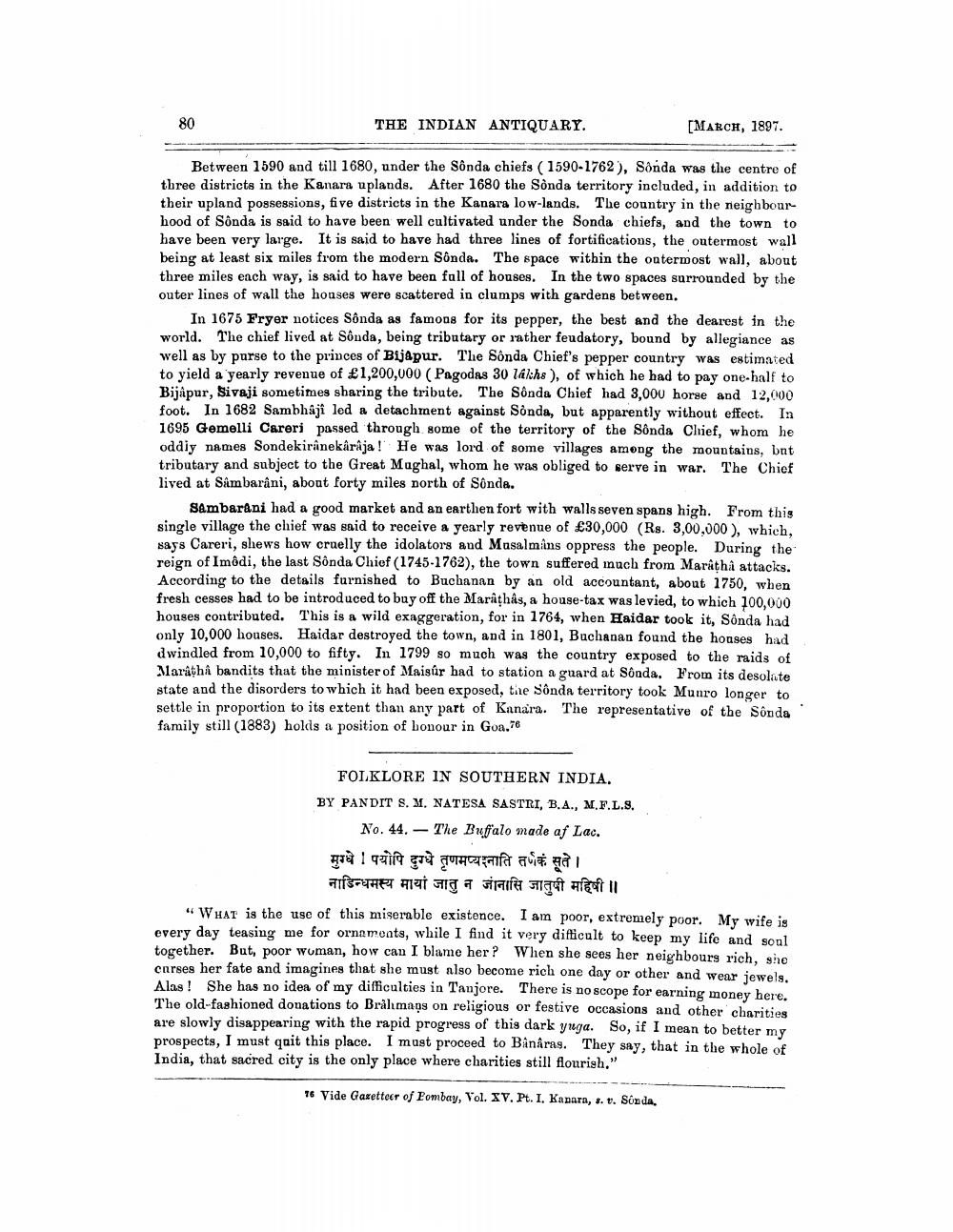________________
THE INDIAN ANTIQUARY.
[MARCH, 1897.
Between 1590 and till 1680, under the Sônda chiefs (1590-1762), Sônda was the centre of three districts in the Kanara uplands. After 1680 the Sônda territory included, in addition to their upland possessions, five districts in the Kanara low-lands. The country in the neighbourhood of Sonda is said to have been well cultivated under the Sonda chiefs, and the town to have been very large. It is said to have had three lines of fortifications, the outermost wall being at least six miles from the modern Sônda. The space within the outermost wall, about three miles each way, is said to have been fall of houses. In the two spaces surrounded by the outer lines of wall the houses were scattered in clumps with gardens between.
In 1675 Fryer notices Sônda as famous for its pepper, the best and the dearest in the world. The chief lived at Sônda, being tributary or rather feudatory, bound by allegiance as well as by purse to the princes of Bijapur. The Sônda Chief's pepper country was estimated to yield a yearly revenue of £1,200,000 (Pagodas 30 lakhs), of which he had to pay one-half to Bijapur, Sivaji sometimes sharing the tribute. The Sônda Chief had 3,000 horse and 12,000 foot. In 1682 Sambhaji led a detachment against Sønda, but apparently without effect. In 1695 Gemelli Careri passed through some of the territory of the Sônda Chief, whom he oddiy names Sondekirînekárâja! He was lord of some villages among the mountains, but tributary and subject to the Great Mughal, whom he was obliged to serve in war. The Chief lived at Sambarani, about forty miles north of Sônda.
Sambarani had a good market and an earthen fort with walls seven spans high. From this single village the chief was said to receive a yearly revenue of £30,000 (Rs. 3,00,000), which, says Careri, shews how cruelly the idolators and Musalmans oppress the people. During the reign of Imódi, the last Sônda Chief (1745-1762), the town suffered much from Marâtha attacks. According to the details furnished to Buchanan by an old accountant, about 1750, when fresh cesses had to be introduced to buy off the Marathas, a house-tax was levied, to which 100,000 houses contributed. This is a wild exaggeration, for in 1764, when Haidar took it, Sônda had only 10,000 houses. Haidar destroyed the town, and in 1801, Buchanan found the houses had dwindled from 10,000 to fifty. In 1799 so much was the country exposed to the raids of Maratha bandits that the minister of Maisúr had to station a guard at Sônda. From its desolate state and the disorders to which it had been exposed, the Sônda territory took Munro longer to settle in proportion to its extent than any part of Kanara. The representative of the Sonda family still (1883) holds a position of bonour in Goa.76
FOLKLORE IN SOUTHERN INDIA. BY PANDIT S.M. NATESA SASTRI, B.A., M.F.L.S.
No. 44. - The Buffalo made af Lac. मुग्धे ! पयोपि दुग्धे तृणमप्यदनाति तर्णकं सूते।
नाडिन्धमस्य मायां जातु न जानासि जातुषी महिषी ॥ “WHAT is the use of this miserable existence. I am poor, extremely poor. My wife is every day teasing me for ornaments, while I find it very difticult to keep my life and soul together. But, poor woman, how can I blame her? When she sees her neighbours rich, she carses her fate and imagines that she must also become rich one day or other and wear jewels. Alas! She has no idea of my difficulties in Tanjore. There is no scope for earning money here. The old-fashioned donations to Brålumaņs on religious or festive occasions and other charities are slowly disappearing with the rapid progress of this dark yuga. So, if I mean to better my prospects, I must quit this place. I must proceed to Binaras. They say, that in the whole of India, that sacred city is the only place where charities still flourish."
76 Vide Gazetteer of Bombay, Vol. XV. Pt. I. Kanara, I. t. Sönda.




